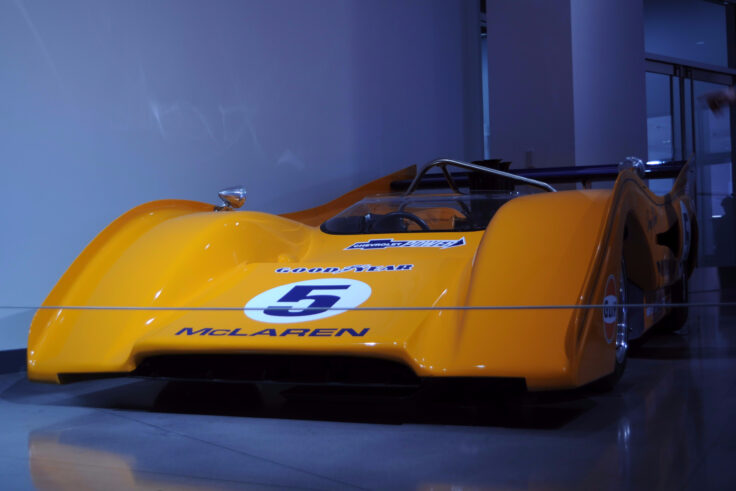A True Motorsport Story For All Enthusiasts
The Petersen Automotive Museum glistened during sunset on June 24th as a crowd gathered into the Bruce Meyer Family Gallery. Among the crowd was Magnus Walker, the director of the film Roger Donaldson, Bruce Meyer himself, and members of the press. A theater had been set up in the middle of the room surrounded by gorgeous landmark Ferrari’s, like Niki Lauda’s Monaco car, LeMans cars, GT cars, and a La Ferrari. However, we were all here celebrating a different legacy.
What most people know about McLaren is that it is an English automotive company named after Bruce McLaren, with a passion for unadulterated performance. However, not many know about the true origins of the company. This is what helped drive director Donaldson to make the documentary McLaren. The film goes through Bruce McLaren’s life from an early age, where he grew up in New Zealand in a wrench-turning household. Bruce would help his father at the family’s automotive shop, but he would also help build karts and cars to compete in races with. He had issues with mobility growing up, but it never stopped him from his passion of tinkering with cars and being behind the wheel.
During the 1930’s and 40’s, New Zealand was more remote, so parts for vehicles were harder to come by. As a result, there was a lot of experimentation and originality in builds. Early on, Bruce was a competitive driver and eventually moved onto the local Grand Prix races. His skills behind the wheel along with his automotive knowledge stood out to John Cooper, who hired him on. Bruce was involved with the cars both behind the wheel and under the hood. Having access to proper parts and a track, McLaren’s racing career really took off.
The film features video and audio clips of McLaren’s early competing races and the development of his cars. Motorsport legends such as Mario Andretti, Emerson Fittipaldi, Alastair Caldwell, and others are featured in the documentary. They spoke about the true passion and thirst Bruce had for motorsport performance along with the dangers of racing back before safety regulations. Loss of life was not unusual on the track, but looking death in the face didn’t stop these competing drivers. As his wins started adding up, Bruce wanted to leave a mark on his builds. His logo included the kiwi bird, which is the national symbol of New Zealand, and also the nickname of the citizens. After leaving Cooper in 63, he went on to form the Bruce McLaren Motor Racing Team.
The story continues with Bruce getting his racing team off the ground, and how he built it up. He never wanted to borrow money, and drove for companies to fund the team. Watching the development of McLaren’s career is awe-inspiring. The man was a sheer genius, both on and off the track. Every vehicle he drove was tested on the track until it was perfect, and he was still hand on with each car before racing. However, while testing one of the Can-Am cars (the brother to the one pictured) he was involved in a fatal accident at the age of 32. The team wanted to carry on his legacy, so they continued to race and build the company into the McLaren Automotive we know today.
During the Q&A following the film, fellow New Zealander Donaldson explained how he got the ability to make the documentary. He was working on his second film project looking for a special car, when he met Bruce McLaren’s father. The McLaren family had plenty of video and audio clips from Bruce’s life, and after two years, Donaldson obtained enough footage to be able to create the film. It’s an incredible documentary, and the footage shows the kind of man Bruce McLaren truly was. Donaldson wanted to tell his story, a proud New Zealander, father, husband, driver, and Motorsport revolutionary.
